new posts in all blogs
Viewing: Blog Posts Tagged with: Sudipta Bardhan-Quallen, Most Recent at Top [Help]
Results 1 - 13 of 13
How to use this Page
You are viewing the most recent posts tagged with the words: Sudipta Bardhan-Quallen in the JacketFlap blog reader. What is a tag? Think of a tag as a keyword or category label. Tags can both help you find posts on JacketFlap.com as well as provide an easy way for you to "remember" and classify posts for later recall. Try adding a tag yourself by clicking "Add a tag" below a post's header. Scroll down through the list of Recent Posts in the left column and click on a post title that sounds interesting. You can view all posts from a specific blog by clicking the Blog name in the right column, or you can click a 'More Posts from this Blog' link in any individual post.
b y Sudipta Bardhan-Quallen
y Sudipta Bardhan-Quallen
It’s still early in Picture Book Idea Month, and hopefully you’re all still overflowing with ideas that you can put down on paper. It does get tougher as the month continues, but bravo to you for taking up the challenge!
You’re going to come up with a lot of different kinds of ideas. You’ll think of titles, puns, and images that you see in your mind’s eye. You’ll imagine complicated scenarios and Holy Grails. You’ll draft punchlines and scenes that tug at the heart. All of these varied things can eventually grow into a beautiful, successful picture book.
But no matter what you start with, character is almost always the key to crafting a book that will be published.
POPPYCOCK! you say. CODSWALLOP! BUNK! After all, there are so many other things we hear about that make editors want to publish a manuscript. Compelling plots. Flawless writing. Powerful marketing hooks. And those are all vital things! Your plot has to be gripping and unique. The writing must be impeccable and beautiful to read. There has to be hooks to help the book sell.
But all of those things pale in comparison to the character.
It is the character that the reader will fall in love with. It is the character who he will root for. It is the character he will draw on his fan mail to you. It is the character who will live on in his imagination for week, months, years to come.
It is the character you have to get right.
Let’s talk about some ways to do that.
Character is Like the Salt

Every once in a while when I’m cooking dinner, I totally forget to add salt. The meal I end up with is nothing short of disgusting and inedible. Salvageable, yes—as long as I add some salt to it. But without that one ingredient, dinner is nothing like what it is supposed to be.
Character is the salt in your picture book idea.
Some meals use a lot of salt. Others, just a sprinkling. But salt is essential. The same holds true for character.
Even in a high concept idea (which is becoming increasingly popular in picture books), you still need that sprinkling of salt, errrr, character. Here’s an example: I have a book coming out soon called RUTABAGA BOO (which will be illustrated by the uber-talented Bonnie Adamson). The entire book is about the unbreakable bond between a son and his mother. Whenever the son needs his mother, he says, “Rutabaga!” To show that she is there, she answers, “Boo!”
On the surface, it may not seem like there is a lot of character in this idea. (I mean, how much character development can you show in 22 words?) But while the heart of this story is the mother/son bond, what draws the reader in is what you learn about the characters—and how much those details endear the characters to the reader. Every spread tells you something more about the characters—what they like to do, what scares them, what makes them feel better. The characters in this case may just be a sprinkling of salt—but without them, the story doesn’t mean nearly as much to the reader.
Think Wedding Cake, Not Cupcake

Let’s belabor the cooking theme some more.
As you are thinking of you PiBoIdMo ideas (and you are focusing on character because you, like me, believe character is the key), make sure you incorporate layers from the beginning. Just like a wedding cake is more impressive because of its tiered layers, you want to create a character that has, well, tiers and layers. Don’t let your idea stand at “Cindy wants a new puppy.” Push it to the limit (even at the idea stage):
- Can you enhance the theme? “Cindy wants a puppy so she can join the kids who walk their dogs afterschool and make some new friends” or “Cindy wants a puppy so she isn’t so lonely”
- Can you ratchet up the conflict? “Cindy wants a puppy but her father hates dogs” or “Cindy wants a puppy – but she only wants responsibility for the top half (the bottom half – and anything that comes out of the bottom – should be her brother’s responsibility!)”
- Can you make your character a study in contradictions? “Cindy wants a new puppy—and yet, she is allergic to dog hair!” or “Cindy wants a puppy but she already has a kitten who is deathly afraid of dogs”
Every time you add a layer to the idea, you make your story inherently more interesting. And no matter where you add the layer, try to leverage into making the character more complex.
To go back to the RUTABAGA BOO example, layers were very important to make that story meaty enough to merit a hardcover picture book. It wasn’t enough to say that the son wanted to be with his mother in a whole bunch of different scenarios. When I wrote the story, I thought about all the different reasons that children want their parents. Would he look for her when he was hungry? When he was scared? How would those look different? How about when the boy was excited – how would he look for his mother then? When he was lonely? When he was tired? What kinds of scenes would show all these diverse interactions that create a relationship?
I started with the cupcake model of “sons like having their mothers nearby” and added tiers to make the story mouthwatering. In 24 words (and Bonnie’s beautiful illustrations, the reader is left with a full depiction of the mother / son bond – and meets characters that they can identify with.
Envision Your Character
After I’ve lectured you on the importance of character, I’m sure you’re all committed to brainstorming great characters every day of PiBoIdMo 2014. So now I’d like to give you a tool to help you with that.
When I teach kids at author visits about developing characters, I give them a graphic organizer to help them get their thoughts down on paper. As it turns out, that organizer works really well for picture book authors, too. (I know. I use it!) So here you go, PiBo-ers! Your own Character Graphic Organizer to help you develop your ideas…
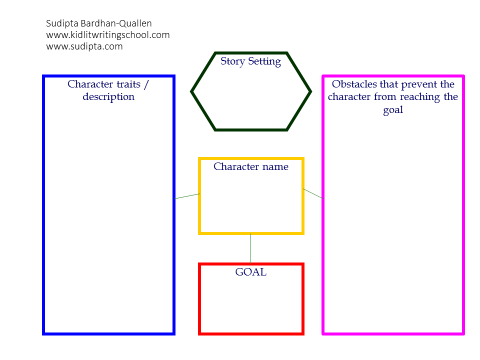
Click for full-sized, printable version.

Sudipta is an award-winning author of over 40 books and the co-founder of both Kidlit Writing School and Kidlit Summer School. Her books include DUCK DUCK MOOSE, TYRANNOSAURUS WRECKS, ORANGUTANGLED, and over thirty more books that have been acclaimed by the Junior Library Guild, the California Reader’s Collection, the Bank Street Books Reading Committe, the Amelia Bloomer list, and many more. Find out more about her by visiting SUDIPTA.COM or her blogs NERDYCHICKSRULE.COM and NERDYCHICKSWRITE.COM.
Facebook: https://www.facebook.com/SudiptaBardhanQuallen
Twitter: @SudiptaBQ
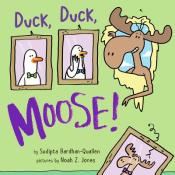



One lucky commenter will receive a free picture book course at Kidlit Writing School! Our next picture book course will be on character development in picture books. The winner can opt to take that course or any other picture book course offered in 2015.
This prize will be given away at the conclusion of PiBoIdMo. You are eligible for this prize if:
- You have registered for PiBoIdMo.
- You have commented ONCE ONLY on today’s post.
- You have completed the PiBoIdMo challenge. (You will have to sign the PiBoIdMo Pledge at the end of the event.)
Good luck, and happy brainstorming!
As a bonus, ALL PiBoIdMo participants who register for a class during PiBoIdMo can get a discount on picture book courses at Kidlit Writing School by going to the secret PiBoIdMo page: http://www.kidlitwritingschool.com/piboidmo-special-registration.html. Find the coupon code to get your discount—just make sure you register before November 30!



By: Kathy Temean,
on 9/13/2014
Blog:
Writing and Illustrating
(
Login to Add to MyJacketFlap)
JacketFlap tags:
picture books,
opportunity,
How to,
children writing,
Sudipta Bardhan-Quallen,
Online Writing Course,
demystify,
Picture Book A to A series,
Plotting in Picture Books,
Author,
Add a tag
 Bonus Critique: Register before September 20, 2014 and receive a free picture book manuscript review and 20-minute Skype session with Sudipta Bardhan-Quallen, redeemable within six months of the course’s completion.
Bonus Critique: Register before September 20, 2014 and receive a free picture book manuscript review and 20-minute Skype session with Sudipta Bardhan-Quallen, redeemable within six months of the course’s completion.
Four Week Online Class starts October 6, 2014
Cost: $250
Author Sudipta Bardhan-Quallen is proud to offer the first in this series, a course on Plotting in Picture Books.
The Picture Book A to Z series is designed to be a collection of master level classes that cover all of the fundamentals of picture book craft. While each class is complete on its own, taken together, the series will teach you everything you ever wanted to now about picture books — and a lot more!
What You Will Learn
The ability to craft a strong picture book plot is one of the factors that separates unpublished writers from those who consistently sign publishing contracts to see their work in print. This course will teach you the essentials of creating compelling plots, starting with Arcs, Beginnings, and Climaxes — then literally taking you through the alphabet. Each topic will be explored in depth, both in the lessons and in the discussion forums and webinars. The writing exercises that are a part of the course are designed to help you apply the lessons to your own writing seamlessly and immediately. By the end of the course, you will never look at plotting the same way again!
How the course is structured:
- Lessons will be posted daily Mondays-Fridays during the four weeks of the course. They will remain online for four months (until February 28, 2015) so students can work at their own pace.
- A weekly webinar will address topics related to the class. Webinars will also provide an opportunity for personal feedback from the instructors. They will be recorded and available for students to access for four months after the completion of the course.
- Students will be able to interact with the instructors and each other via an organized, private message board hosted just for each class. This will be an excellent resource to form critique groups, to freely ask questions, and to support each other as you launch into your projects.
Optional Add on Critique: Add an in-depth picture book manuscript critique with an hour-long Skype session with Sudipta Bardhan-Quallen at a special class-only discounted rate.
Bonus Critique: Register before September 20, 2014 and receive a free picture book manuscript review and 20-minute Skype session with Sudipta Bardhan-Quallen, redeemable within six months of the course’s completion. In addition, you will be entered to receive a free written critique of a picture book manuscript (up to 1,000 words) from Agent Rachel Orr of the Prospect Agency.
Click this link to register: http://www.kidlitwritingschool.com/picture-book-a-to-zs–plotting.html
Talk tomorrow,
Kathy
Filed under:
Author,
children writing,
demystify,
How to,
opportunity,
picture books Tagged:
Online Writing Course,
Picture Book A to A series,
Plotting in Picture Books,
Sudipta Bardhan-Quallen 

by Sudipta Bardhan-Quallen
 It’s back to school season here in New Jersey (or, outside Philadelphia, as I typically refer to it) and that means big changes in my household. All summer, my kids and I are bums. We hang out at the beach, at the pool, at the mall. We travel, we sleep in, we do nothing. Summer is heaven.
It’s back to school season here in New Jersey (or, outside Philadelphia, as I typically refer to it) and that means big changes in my household. All summer, my kids and I are bums. We hang out at the beach, at the pool, at the mall. We travel, we sleep in, we do nothing. Summer is heaven.
But come September, my children’s lives change. Gone are the no schedule, no stress days and in their place we have wake up alarms, agenda books, and deliverables (and, it seems, a LOT of laundry!). The kids aren’t the only ones who go back to school—as a children’s book author, the school year means that I go back to school as well.
Every year, between school visits, Skype visits, and events like Dot Day or World Read Aloud Day, I connect with about 100 different schools all around the world. Because I spend so much time with school kids, I end up doing quite a bit of teaching, especially teaching writing. Which happens to be a completely different skill than actually writing.
There is a very stupid expression that you sometimes hear people throw around: “Those who can, do. Those who can’t, teach.” I want to be very, very clear here: that is one of the dumbest things I’ve ever heard. Not only is it disparaging, inflammatory, and demeaning, it also has the distinction of being very WRONG. I definitely knew that before I personally started working with schools, but now that I teach on a regular basis, I can tell you that those who teach can do better than anyone else.

It has to do with the nature of teaching. In order to teach someone a skill, you have to know it so well that you can explain every step, even the ones you do automatically or on muscle memory. Here’s an example: when I was in graduate school, I bought a brand new Mustang that I couldn’t drive. Because it was a stick shift and I only knew how to drive an automatic. So I had a friend try to teach me how to drive stick. We got in my car, I started it up, and I asked him what to do next. He said, “OK, now drive.” I looked at him blankly. “Just don’t stall the car,” he added. I had no idea what that meant. So he said, “Don’t ease off the clutch to quickly. Or too slowly!”
At that point, I threw him out of the car. He, to this day, doesn’t understand what had upset me.
He knew how to drive a manual, and things that I needed to know—how to properly come off the clutch when changing gears, how to tell when to shift up or down, etc.—were things he’d stopped thinking about. So he couldn’t teach me to do them because he hadn’t been thinking about all those little steps that you do to succeed that once you’re successful, you completely forget about.
(For the record, I can now totally drive a stick.)
When I started teaching writing, I struggled with this same thing. I thought to myself, How can I teach something that I just DO? Trust me, this was very difficult to figure out. But the more I did figure it out—the better I got at teaching others how to write—the better I actually got at writing. Just like my friend who failed at teaching me how to drive my Mustang because there were so many things he was doing on autopilot that he couldn’t explain, as writers, we do that same thing. When you get to a certain point in your writing journey, you don’t even think about certain things like how to conceptualize a complex character or add layers to your plot, you just do it. But if you try to teach someone else how you do what you do, you have to break down every action into baby steps so that you can show your students how to mimic your actions. This forces you to think through your methods, and in the process, refine them even more.
So even if you’re not at the point in your publishing career where you are teaching, I’d like to encourage you to think like a teacher to become a better writer. For example, instead of saying, “I’m going to create a charismatic main character,” I’d ask you to analyze what steps you’d take to do that, like:
- Start with something familiar
- Add some positive unique features
- Give the character some flaws that make him or her relatable
- Give him or her positive relationships (family, best friend, etc.) and negative relationships (nemesis, villain, etc.)
- Temper every extreme (like “good” or “bad”) with something that brings it back a notch (like “good but hates kittens” or “bad but rescues kittens”)
The more you go through this process of treating your writing objectives like lesson plans, the deeper you’ll understand what you’ve done when something work—and what you may have left off inadvertently when something doesn’t work.
When you’re a good teacher, your students will benefit. When you yourself are your own student, your teaching skills make you so much better at doing.
Happy Back to School!
 Sudipta is an award-winning author of over 40 books and the co-founder of both Kidlit Writing School and Kidlit Summer School. Her books include DUCK DUCK MOOSE, TYRANNOSAURUS WRECKS, ORANGUTANGLED, and over thirty more books that have been acclaimed by the Junior Library Guild, the California Reader’s Collection, the Bank Street Books Reading Committe, the Amelia Bloomer list, and many more. Find out more about her by visiting Sudipta.com or her blogs Nerdy Chicks Rule and Nerdy Chicks Write.
Sudipta is an award-winning author of over 40 books and the co-founder of both Kidlit Writing School and Kidlit Summer School. Her books include DUCK DUCK MOOSE, TYRANNOSAURUS WRECKS, ORANGUTANGLED, and over thirty more books that have been acclaimed by the Junior Library Guild, the California Reader’s Collection, the Bank Street Books Reading Committe, the Amelia Bloomer list, and many more. Find out more about her by visiting Sudipta.com or her blogs Nerdy Chicks Rule and Nerdy Chicks Write.
Sudipta’s new class: Picture Book A to Z’s: Plotting in Picture Books
The Picture Book A to Z series is designed to be a collection of master level classes that cover all of the fundamentals of picture book craft. While each class is complete on its own, taken together, the series will teach you everything you ever wanted to now about picture books- and a lot more!
The ability to craft a strong picture book plot is one of the factors that separates unpublished writers from those who consistently sign publishing contracts to see their work in print. This course will teach you the essentials of creating compelling plots, starting with Arcs, Beginnings, and Climaxes — then literally taking you through the alphabet. Each topic will be explored in depth, both in the lessons and in the discussion forums and webinars. The writing exercises that are a part of of the course are designed to help you apply the lessons to your own writing seamlessly and immediately. By the end of the course, you will never look at plotting the same way again! The first course in this series, Plotting in Picture Books, will begin on October 6, 2014.
Bonus Critique: Register for Plotting in Picture Books before September 20, 2014 and receive a free picture book manuscript review and 20-minute Skype session with Sudipta Bardhan-Quallen, redeemable within six months of the course’s completion.
Thanks, Sudipta! And now for the giveaway…either a 20-minute telephone/Skype PB critique with Sudipta or one of her signed books. The choice is yours. Just comment once below by September 16th to enter!


Today there’s not one guest post, but TWO. On the radio, this would be called a TWO-FER TUESDAY. But it’s Thursday. Yeah, this is why I’m not on the radio.
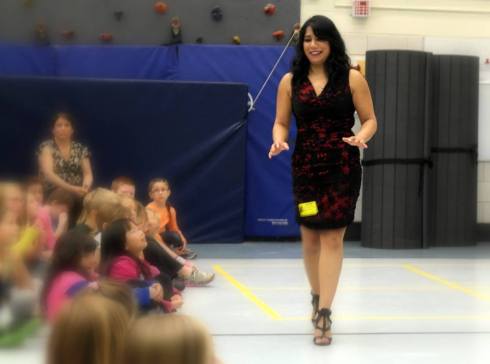
My Favorite Parts of Writing for Kids by Sudipta Bardhan-Quallen
So far, 2014 has been a really big year for me. I’ve had four picture books come out in the first four months of the year—DUCK DUCK MOOSE, ORANGUTANGLED, TYRANNOSAURUS WRECKS, and SNORING BEAUTY. I’ve had books selected for the Junior Library Guild, chosen as Amazon Big Spring Picks, and reviewed in the Wall Street Journal. I also joined the faculty of the Children’s Book Academy and began teaching writing.
Almost 12 years ago, I made the decision to leave graduate school in biology and begin writing books for children. In that time, there have been many highs and lows, though right now is certainly one of those highs. In light of the good fortune I’m experiencing right now, I wanted to share my three favorite parts of being a children’s author.
- Nobody tells me what to write about.
Every project I take up, I do so because it is something that interests me. I get to decide what to write about, and if that means spending one day on a concept book about the bond between a mother and a son, the next day on a picture book biography of Jackie Robinson, and the next on a story of some ducks whose best friend always MOOSES everything up, I can certainly do so (and I have!). It is a wonderful thing to have complete control over what I have to work on.
- I can work barefoot in my bed in my pajamas.
In the spirit of no one telling me what to do, I don’t even have a boss who makes me get dressed before I go to work! Some of my finest writing has come out of the left side of my bed, under the covers with my feet poking out.
- I get to create something out of nothing.
This one’s the key. In so many jobs, people follow instructions, push paper from one end of their desk to the other, execute against a task list. I’m not knocking those jobs at all—without them, our world doesn’t work. I’m just saying that it’s very rare to be able to start with nothing—just me and my imagination (and my laptop!) – and end up with something that is real and good, that didn’t exist before, that is entirely the product of my willing it into existence. Artists are driven to create. To be able to follow that imperative and still be able to support my family—well, that’s what I’m most grateful for. That’s my favorite part.
Happy Writing!
.

My Favorite Parts of Teaching and Agenting by Mira Reisberg
That part is easy–helping!! This helping boils down to helping make dreams come true, helping people improve their skills, helping to create a more level playing field with Children’s Book Academy scholarships, helping get great books and art out into the world created by great people, and finally helping bring more happiness and joy in the world (oh and having fun playing with people, words, and images).
Being a creative is hard. We live in a culture that generally undervalues and underpays us though this seems to be shifting a bit with new technologies where there is more of an emphasis on storytelling and image-driven messages.
But the payoff, and it’s big, even if it does take a long time for the money to come, is having a meaningful, heart-filled, and very fun life. I was talking with another agent this morning where we were helping each other out and it was just so lovely. That’s what we do in community-oriented organizations like PiBoIdMo, Rate Your Story, the Society of Children’s Book Writers and Illustrators, and the Children’s Book Academy, and this is another thing that I love about what I do.
In the old days, being a writer or illustrator meant slaving away in isolation. Now we have all these fantastic resources that not only help us with our craft, but also with our hearts providing support, resources, companionship, and practical assistance. So if you are feeling isolated or stuck, just reach out and ask for help. How amazing that we can do this. I certainly couldn’t be doing what I do at any other time in history. In some ways I love what I do a little too much and having a slightly addictive personality, tend to do too much. But this is a small price for all the joy and happiness that I get from being creative and helping others. So I guess this is another thing that I love about what I do, getting to live a wildly creative life and do good at the same time.
.
Tara’s Favorite Part of This TWO-FER
Years ago, I attended NJ-SCBWI events to learn about the business and craft of writing for kids. That’s where I met Sudipta. She has taught numerous picture book courses. She’s the most savvy and knowledgable instructor I know. She has taught me story techniques that no one else has ever divulged!
And now everyone has the chance to gain writerly wisdom from Sudipta. Along with Mira, she’s teaching the outrageously interactive online course: “From Storyteller to Exquisite Writer: The Pleasures and Craft of Poetic Techniques” starting May 19th. Mira and Suipta have nicknamed this course “The Missing Link” because it really is what most writers are missing in foundational knowledge. CLICK HERE for details and top secret discounts. This is the only time that Sudipta and Mira will be co-teaching this course together with the wonderful Mandy Yates assisting.
Thanks, Sudipta & Mira!
So now it’s your turn. What are your favorite parts of what you do?



By:
Tara Lazar,
on 3/21/2014
Blog:
Tara Lazar
(
Login to Add to MyJacketFlap)
JacketFlap tags:
Marketing,
Picture Books,
Book Marketing,
Sudipta Bardhan-Quallen,
Duck Duck Moose,
Snoring Beauty,
Orangutangled,
Nerdy Chicks Rule,
Tyrannosaurus Wrecks,
Add a tag
 by Sudipta Bardhan-Quallen
by Sudipta Bardhan-Quallen
As an author, I look forward to my next book release the way parents look forward to the birth of their child. After all, the release date is a birthday of sorts—the day my creation is real to everyone, not just me! If you’ve ever known someone expecting twins, the excitement is even higher—though, the fear associated with the event is also heightened.
This year, I’m having the publishing equivalent of quadruplets:
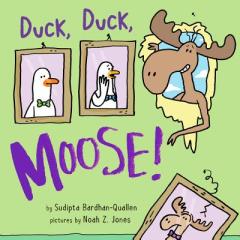


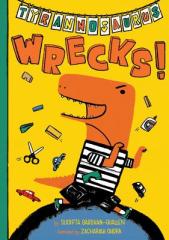
Like I said, I’ve got 99 problems, but a book ain’t one.
I get it. To have her problems, you might be thinking. After all, too many things publishing is a far better problem than too few. Or none at all. But there are problems created by my multiple birthing. Here are a few things you might not consider when praying for a year like this:
- The whirlwind of marketing becomes a tornado.
Since January, I’ve done three blog giveaways (the first was a DUCK, DUCK, MOOSE package of a book, a book, and a package of magic erasers, the second was a piece of Aaron Zenz’s original art, and the third is the autographed book we will give away here on this blog) with a fourth one coming up. I’ve done 42 Skype classroom visits—not including the 14 I have scheduled for the TYRANNOSAURUS WRECKS launch. I’ve flown to a conference in California and done a bunch of signings. I’ve revamped my website, I’ve had educator guides created, I’ve read the books so many times I have them memorized. And on the 7th day I rested…except, not really. Remember, all these marketing things are in addition to my regular job of writing, revising, preparing workshops, creating professional development. Oh, and raising all my kids.
 Too much of anything is good for nothing.
Too much of anything is good for nothing.
As much as we want to see our books in print, publishing is about more than just personal accomplishment—t’s about sales. While my ego might be excited by multiple books out at the same time, the market is another story. Have you ever heard of market saturation? Economic theory says in a given market, only so much growth can be supported. For authors, that means there are only so many new books a consumer will buy at a given time. Having too many books at once can actually reduce the probability that a fan will buy all of them, just because he may not want to buy more than a certain number of books within a short time period. This principle also extends to recognition. It’s highly unlikely that you’d have multiple books nominated for a given award in the same year. So you’ve increased your overcall competition by competing with yourself.- The “what have you done for me lately?” problem.
Let’s face it—people are basically raccoons, distracted by whatever is new and shiny. And if you have a bunch of books come out at once, chances are, that will be followed by a long gap until your next release. But a book only keeps it’s “new car smell” for a finite amount of time. When something else new and shiny comes along, you won’t be able to compete and the raccoons will move on.
So, who still wants to have lots of books published at once? And who doesn’t?
Well, let me tell you a secret—it’s not up to you.
For the most part, publishers work on their schedule. And their concerns aren’t your concerns. So books may come out slowly at regular intervals, or they might appear all at once. As authors, we don’t have much say in this.
So how do you deal with this? How can you turn all these negatives into something positive for you?
I’ve given you the problems, so let me propose some solutions:
- Find your overarching narrative.
Whenever I have a book release, I take the details of its inspiration and craft a storyline that matches to a theme. For example, every night at bedtime in my house, my kids go nuts. My son, especially, when he was younger, he refused to sleep—no naps, no bedtime, no nothing. He was absolutely convinced I was going to do something awesome. This became the backstory for CHICKS RUN WILD, and I’ve introduced the book to hundreds if not thousands of readers by telling this story. With each of your books, you should be creating a narrative as well—but when you have multiple books at once, think of an umbrella narrative that talks about all the books. For example, DUCK, DUCK, MOOSE and ORANGUTANGLED are both about having bad days (though they resolve that issue differently). When I talk about them together, I tell my audience about taking bad days, mistakes, blunders and turning them into inspiration. They’re also both about friendship, and the different ways your friends can help you get through a rough patch. When you have one narrative, that message starts to represent you as a brand instead of the individual products/books. And at the end of the day, you want fans of your brand, not just your book.
- Coordinate efforts.
When you start marketing one book, leave yourself openings to market the others. For example, when I was booking release day virtual visits for SNORING BEAUTY and I had too many requests, I offered the folks I couldn’t schedule in March a spot on the TYRANNOSAURUS WRECKS release day. So instead of having to start from scratch for the next release, I’ve got some legwork done already.
 Use this principle in your marketing materials, too. Having bookmarks printed? Think about designing something that works for all your new releases. Making postcards? Create a “New for 2014” card instead of individual designs.
Use this principle in your marketing materials, too. Having bookmarks printed? Think about designing something that works for all your new releases. Making postcards? Create a “New for 2014” card instead of individual designs.
Just breathe. As I said before, in the grand scheme of things, having too many things published at once is the better dilemma to have. Because if you’ve got to have 99 problems, at least a book ain’t one.
.
Thank you, Sudipta! This is all good to know since I will be having two books released in 2015! Yikes! TWINS! Somebody boil some water!
Do you have any questions or comments for Sudipta? Leave a comment below and you’ll be entered to win a signed copy of one of her 2014 books, YOUR CHOICE! (And a tough choice it is!)
Also be sure to visit Sudipta’s awesomely nerdy blog, Nerdy Chicks Rule.


 by Sudipta Bardhan-Quallen
by Sudipta Bardhan-Quallen
It’s Picture Book Idea Month, and I’m going to give you a math lesson.
Who remembers high school math? A long time ago, we may have learned about combinations of variables. As we go through PiBoIdMo, we need to explore different combinations to discern the optimal result.
Now, you’re thinking, well, no kidding. How does that help me?
Aren’t you lucky? I’m going to tell you.
- Step One: Finding the Variables
If you are like me, you try to come up with picture book ideas as complete entities: a character with a specific problem/resolution. But just like in your manuscript drafts, your first idea isn’t necessarily your best idea, and it definitely doesn’t need to be your last idea. If you allow yourself the freedom to separate your idea into it’s entities, you might end up with something better.
Think of it this way: if you come up with 30 characters over the next month (let’s call this variable C) with 30 definite story outcomes (this variable will be O), all you have is 30 ideas to work with. On the other hand, if you have 30 characters, each of whom has 30 story outcomes, you have many more possible ideas to develop. Mathematically, the total number of combinations is represented by this formula:
Number of combinations = C x O
In this case, you end up with 30 x 30 = 900 story ideas at the end of PiBoIdMo. That’s accomplishing a lot, isn’t it?
Basically, separating your ideas into building blocks—into variables—allows you to have useful partial ideas. How many times have you realized that there really needs to be a book about a certain topic? Or come up with an adorable character for whom you can’t think up a story?
Write these down. Add them to your C and O lists. Every once in a while, look over the lists and see if there is a combination you see that resonates with you that was different than what you originally imagined. Allowing these partial ideas to have value takes a lot of pressure off you as a writer and creator. It is very hard to have a good idea every day! But just because something isn’t the perfect idea doesn’t mean you can’t make it work for you.
- Step Two: Expanding the Combinations
A good book has a main character and a primary plot. Many books, however, have secondary characters. Some books have secondary plots.
What if some of your PiBoIdMo ideas don’t work as stories because you came up with a secondary character or a plot?
Some books even have a pair of main characters (mash-up, anyone?) What if one of your character ideas would be four times as strong if you combine it with another character?
If you combine even more variables, you make your work go even further:
Number of story ideas with 2 characters = C x (C-1) x O = 30 x 29 x 30 = 26,100 ideas!
(and a secondary plot on top of this…you get the idea…)
Again, allowing yourself to have incomplete ideas gives you the freedom to pursue many more possibilities.
Obviously, some of the combinations that come out of this process are not going to work. So you really won’t have tens of thousands of ideas to sort through. But hopefully, you’ve picked up on the fact that I’m trying to encourage you to look at your work over this month in a different way.
Whenever you can have a complete story idea, that’s fabulous. Run with it. But don’t get frustrated if inspiration comes in drips and drops instead of a flowing stream. It’s all going to be valuable in the end.
- Step Three: The Idea Wheels
I want to leave you with something fun. I’ve asked you to take your building block story variables and consider them in various combinations. You could create a spreadsheet and be very orderly about it, but what I really want you do to is have fun with it and let the random ideas percolate through your brains. So I’m inviting you to create your own Idea Wheels.
There’s a great site called WheelDecide.com, where you can create your own wheels of fortune, if you will. You can create one wheel for your character ideas and another for your story outcomes. Then, spin away until the wheels hit upon something that really works for you. It’s visual and fun, and if nothing else, there’s a winner every time!
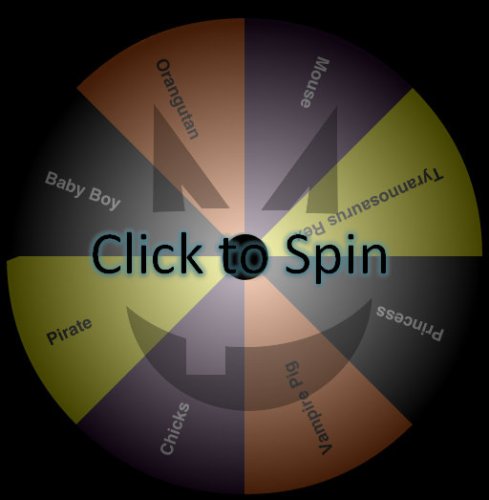
You are all just beginning your PiBoIdMo journey, and it will be a long month ahead. But I hope you stick with it—I bet you’ll come out on the other side with valuable starting points for writing. Good luck!
BONUS!
Last week, this blog hosted a double cover reveal for two of my upcoming picture books. In honor of the reveals, I held a book cover caption contest. It was not easy to pick the winner because there were so many captions that were great! But after careful consideration, on the basis that this caption works so well for BOTH covers, here is the winner:
“Is this as awkward for you as it is for me?”
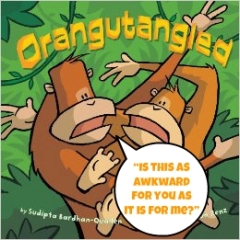
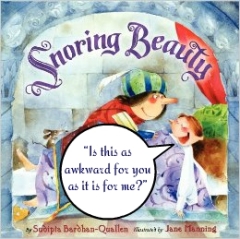
Everyone, please put your hands together for Dawn Young! Dawn wins her choice of a signed copy of ORANGUTANGLED or SNORING BEAUTY! Yay!
And one more bonus…
BONUS: If you’d like more PiBoIdMo tips, pop over to my blog at NerdyChicksRule.com for a great post about knowing what your character wants.

Sudipta Bardhan-Quallen is an award-winning children’s book author whose books include
Chicks Run Wild,
Pirate Princess,
Hampire!, and
Quackenstein Hatches a Family. She visits schools around the country to talk about the craft of writing to children of all ages. “Every book is an autobiography” is a favorite saying of hers, and a big part of her message is that everyone, grownup or child, has a story that is interesting and compelling—if you can find the right words to tell it. Sudipta lives outside Philadelphia with her children and an imaginary pony named Penny. You can learn more about her and her books on her website
www.sudipta.com or at her blog
www.NerdyChicksRule.com.


 by Sudipta Bardhan-Quallen
by Sudipta Bardhan-Quallen
Next year—2014—is going to be a hectic year for me. In January, I’ve got a new book called DUCK DUCK MOOSE releasing, illustrated by the fabulous Noah Z. Jones and published by Hyperion. But that isn’t it for the year! No, I’ve actually got THREE more picture books and a couple novels in the pipeline. It’s going to be quite a year!
I can’t share all the upcoming books with you, but I am thrilled to be able to do this:
A DOUBLE COVER REVEAL!
That’s right, folks, not just one gorgeous cover, but TWO!
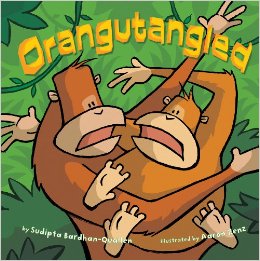
ORANGUTANGLED:
Two orangutans reach for some mangoes, fall, and land in a gooey, gummy mess. Other animals join the fray until there’s a big ball of mango-juice-covered animals rolling down a long hill to the ocean—will they be okay? Or will they make a gooey-gummy tiger treat?
Illustrated by Aaron Zenz
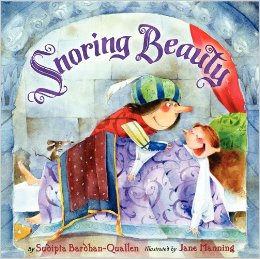
SNORING BEAUTY:
Tucked in his little bed inside the castle walls, Mouse is eager to get a good night’s sleep before his wedding tomorrow. But just as he begins to drift off, he’s awoken by a tremendous roar. SNOOOOGA-SNOOOOOM! KER-SCHUPPP! Sleeping Beauty is snoring . . . again! When the handsome Prince Max arrives, Mouse thinks he’s found the perfect scheme: He’ll convince the prince to kiss Beauty and wake her up! But when Prince Max learns that Beauty is the one making such monstrous noises, will he still want to kiss her . . . or will he run away from the noisy princess, leaving her snoring for another hundred years?
Illustrated by Jane Manning
Now, these covers are in no way alike at all. BUT…what strikes me about both of them is that they are screaming to be captioned!
What are those tangled Orangutans saying?
What is the Princess thinking as the prince gets closer? Like this:
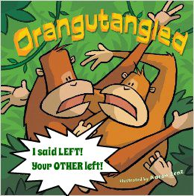
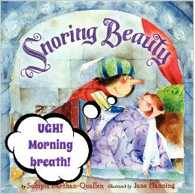
CAPTION CONTEST!
IN HONOR OF THE DOUBLE REVEAL, I’m happy to announce a new giveaway. Here’s what you have to do—just write a caption for one of these covers and put it into a comment below. We’ll keep it open for 7 days and then I will pick my favorite one. The winner will receive a signed book of his or her choice as soon as the books become available!
Good luck, and I’m looking forward to reading your captions!


 So, you’ve finished PiBoIdMo, and now you have all these great ideas. You’re on the road to publication!
So, you’ve finished PiBoIdMo, and now you have all these great ideas. You’re on the road to publication!
Except, you still have to write the books. And that’s not an easy path.
A lot of people think that finding ideas is the hardest part of writing. It’s not. Finding ideas is very difficult, but figuring out which ideas to focus on first and which ones to let linger—that’s the killer. So that’s what I’ll try to help you with today.
Step 1: Get the easy stuff out of the way.
Some stories write themselves, or at least flow out of your mind effortlessly. Get those down on paper first—there’s no reason to not take the path of least resistance.
Step 2: Organize and analyze.
You’ve got 30 picture book ideas. Maybe more. Do you write manuscripts for them in alphabetical order? Chronologically? By order of the number of feet the main character has?
You could do any of those things, but it’s probably not the most efficient route to publication. So instead, I have a system. Here’s where I get nerdy.
You know that program called Excel that math people use but us creative types stay away from? Find it on your computer and start it up. We’re going to create a spreadsheet of ideas.
The idea here is to sort your ideas by various relevant characteristics to make sure you end up with a varied portfolio. After all, just like an illustrator has a style but needs more than paintings of bunnies to create a portfolio that will get him or her contracts, writers need to show range, too. You don’t want your own books to compete with each other —you want every book to have its own independent niche.
Column headings. The column headings will give you a way to list the relevant characteristics and sort your ideas using these.
Everyone may have different column headings, but here are some common ones that everyone should have:
- Title (Obviously)
- Character type (What kind of animal? How old of a human? Etc.)
- Theme
- Setting
- Problem type (Is it a monster? A bad teacher? A parent? A wild animal?)
- Age range (will this be a young PB or one for older kids?)
- Hook (I may actually separate this into sub-categories to make it easier to sort.)
- Institutional hook
- Holiday tie-in
- Developmental milestone
You can add any more headings that make sense to your work.
Create the spreadsheet. Now take all your PB ideas and start filling in the blanks. Now, you may not have a fully fleshed-out plan for each idea—that’s fine, just fill in as much as you can. And this is a place to do some research, too. Look at the market—are there hooks that are more popular than others?
Analyze your data. So you’ve entered your 30 ideas. Now we’re going to rank them.
You probably don’t want to write 16 books about pigs. It would be hard to get them all published before you establish a reputation. Same thing with 6 books about monsters or 3 books about pirates. So look at your spreadsheet and start seeing how you can sort the data.
If you’ve never used Excel, here is a quick tutorial: use the mouse to highlight all your data (not the column headings) and then click on Sort & Filter (in the Data tab of my version of Excel). You should then be able to sort by any of the columns. So if you sort by the column of Character Types (Column B in my spreadsheet) and sort on Values with the Order set to A to Z, all your entries will be rejiggered so you can see all your pig ideas next to each other and all your monster ideas will be next to each other.
Now look more closely at those similar ideas. Is there one that is particularly appealing? Stronger than the others? Incorporating more hooks? Move that to the top of the list. To create that varied portfolio, go through and pick only one idea from each “type” to work on first. When you notice ideas that seem too similar, delete one of them.
Step 3: Write!
I recommend getting a list of about 6 ideas to work on at a given time. Fewer than 6 and you may hit writer’s block, more than 6 and it is hard to keep everything straight. So keep looking at the ideas until you pull 6 good ones. Now you have a plan! From here, all you have to do is write a great manuscript, revise until it is perfect, market it until you find a home, wait for the illustrations, plan for the release, figure out promotions…well, that’s a post for a different day, isn’t it?
In the meantime, go figure out what to work on….
.
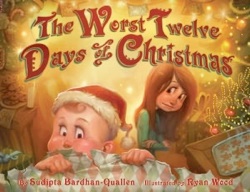 Sudipta Bardhan-Quallen is the award-winning author of many, many books for children, including picture books, nonfiction for young readers, and a forthcoming chapter book series called THE SPECTACLES OF DESTINY (due out in 2014). Her newest release is THE WORST TWELVE DAYS OF CHRISTMAS, illustrated by Ryan Wood. In this spirited reworking of the classic song “The Twelve Days of Christmas,” Joy has to deal with her first Christmas with a new baby brother—and nothing could be worse. A sweet surprise turns the tables on Joy, who eventually appreciates what her baby brother adds to the holiday.
Sudipta Bardhan-Quallen is the award-winning author of many, many books for children, including picture books, nonfiction for young readers, and a forthcoming chapter book series called THE SPECTACLES OF DESTINY (due out in 2014). Her newest release is THE WORST TWELVE DAYS OF CHRISTMAS, illustrated by Ryan Wood. In this spirited reworking of the classic song “The Twelve Days of Christmas,” Joy has to deal with her first Christmas with a new baby brother—and nothing could be worse. A sweet surprise turns the tables on Joy, who eventually appreciates what her baby brother adds to the holiday.
Sudipta speaks at conferences, educator events, and schools across the country, teaching the craft of writing to children and adults. She lives outside Philadelphia with her three children and an imaginary pony named Penny. Learn more about her and her books at www.sudipta.com.


by Sudipta Bardhan-Quallen
 I have no new ideas.
I have no new ideas.
None.
No plan. No flashes of inspiration. No idea where to find an idea.
This is not a new dilemma for me.
The longer I’ve been writing, the more successful I’ve gotten, the harder it becomes to find those ideas that get me excited. Sounds counterintuitive, doesn’t it? Shouldn’t it get easier with experience?
For me, it hasn’t. But that hasn’t stopped me from writing. (After all, this is the sweetest job on earth – not only do I get to create something from nothing, a lot of the time that I’m working, I’m in my jammies in my bed.) So, what’s a girl to do? How do you pull a good idea out of the air?
I don’t really know. But Tara invited me to blog so I thought I’d give y’all some possible places to start.
Look for Nuggets, not Multitudes
Everyone knows you can’t just sit down to write a picture book about a chicken and think that’s all the brainstorming you need to do to run with it. Just “chicken” is too generic, too common, too…uninspired. But what if that’s all you have? Don’t you need a complete plot, a big idea…a whole roaster, so to speak?
Let the chicken be your nugget, no pun intended, and build from there. (And who am I kidding? I totally intended the pun. See below. I don’t stop with the puns.)
I started with a chicken nugget once. I hadn’t written a chicken book. Chickens are adorable. Instant winner.
But I quickly realized that I needed more. For someone to give a cluck about my chicken book, I needed to add some garnish. So I started thinking about chickens and what they do. Eventually, I brainstormed about chicks – but there were so many chick books already. Baby chicks, fluffy chicks, chicks and salsa…the list went on and on. All these chicks in all these books, all running wild…
And then it hit me. CHICKS RUN WILD.
 I took my nugget and grew it to a title. And from there, I…well, ran wild with it. Now, let’s be honest, I took this title and then did what writers all over the world do every day: I wrote about what I knew. CHICKS RUN WILD grew into the story of little chicks at bedtime who don’t want to go to sleep quite yet—it could be an autobiography of bedtime with my own children. So, easily, I could advise you to take inspiration from your life—but you get that everywhere, don’t you? Besides, my point is I only got to writing about what I knew after starting with a small nugget of inspiration. I nurtured that nugget and kept it warm and safe until it grew into a fully formed…idea.
I took my nugget and grew it to a title. And from there, I…well, ran wild with it. Now, let’s be honest, I took this title and then did what writers all over the world do every day: I wrote about what I knew. CHICKS RUN WILD grew into the story of little chicks at bedtime who don’t want to go to sleep quite yet—it could be an autobiography of bedtime with my own children. So, easily, I could advise you to take inspiration from your life—but you get that everywhere, don’t you? Besides, my point is I only got to writing about what I knew after starting with a small nugget of inspiration. I nurtured that nugget and kept it warm and safe until it grew into a fully formed…idea.
What’s in a Name?
OK, let’s shift gears. No more chicken puns. Let’s talk names instead.
Is there anything more immediately suggestive than a character’s name? Think Willy Wonka, or Shrek, or Fancy Nancy—just the names create an image in the reader’s mind. Characters can grow to be iconic – if developed correctly. But you certainly can’t know ahead of time which of your characters will become iconic.
That doesn’t mean you can’t start with character.
The truth is, I think the best place to start is character. When you have an idea for a great character, you need to let him run free (run wild, perhaps?) even before you figure out exactly what that character will do in the story. A strong character will find his story.
![]() 10 Comments on PiBoIdMo Day 9: Sudipta Bardhan-Quallen Has No Idea, last added: 11/9/2011
10 Comments on PiBoIdMo Day 9: Sudipta Bardhan-Quallen Has No Idea, last added: 11/9/2011
By Sudipta Bardhan-Quallen
Illustrated by Howard Fine
$16.99, ages 4-8, 32 pages
A hungry duck makes a late-night dash for a snack, as a fanged beast prowls the farm yard for his next delicious victim, in this hilarious story of misunderstandings.
Until now, no farm animal dared to step a talon or hoof out of its pen when the moon was bright for fear of becoming prey for a great cloaked hog known as Hampire.
They'd seen enough grisly remains from Hampire's feedings, the sticky red fluid dripping off the grass and the red stains on his canines as he returned to his pen.
But on this night Duck is too hungry to be sensible. The rumbling in his tummy is keeping him awake and all he can think about is snacking on the jelly rolls and ice-cream bowls in farmer's kitchen.
So Duck slips out of the barn and into the farmhouse to pile goodies onto a tray to take back to the barn. But as he steps back into the night air, a haunting, ruddy presence rises up behind him: It's Hampire, "grim and dire."
Frantic, Duck flaps off to the chicken coop as Hampire lumbers in pursuit with fangs bared. Duck quickly rouses Red the chicken and yells for him to hide, then both fly the coop as Hampire snuffles his nose inside.
"As Duck raced Red to Pony's stall, / They heard the Hampire screaming. / 'I'm starved, of course -- / I'd eat a horse!' / His pointy fangs were gleaming."
Hampire's rant feeds their fears and they climb onto Pony's back and gallop off to an abandoned shed, as the tray of goodies teeters on Duck's wing. Inside they hear Hampire bellow out that he's hungry and plead with them to let him in.
But none of them trust the beast, so they slam the door in his face and run to the farthest wall to cower in a corner. As Hampire pounds on the walls, Duck d
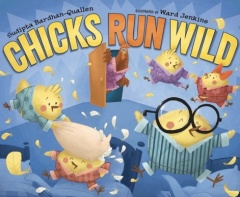 Do you have a love/hate relationship with bedtime? It’s a cozy time to snuggle and read a book with the kids, but it’s also when they refuse to settle down to sleep. Mom, can I sleep in your bed? Dad, can I have a glass of water? Could you fluff my pillow? Can we read one more book? Please? Five more minutes? Pretty please with sugar on top?
Do you have a love/hate relationship with bedtime? It’s a cozy time to snuggle and read a book with the kids, but it’s also when they refuse to settle down to sleep. Mom, can I sleep in your bed? Dad, can I have a glass of water? Could you fluff my pillow? Can we read one more book? Please? Five more minutes? Pretty please with sugar on top?
Ey yi yi. It’s enough to drive any mama hen wild! And it does in Sudipta Bardhan-Quallen’s new picture book, Chicks Run Wild.
In her Coop Sweet Coop, Mama has five chicks to put to bed. She tucks them in, gives them each a peck goodnight, but when she closes the door, they leap out of bed and cause a riotous ruckus. Feathers fly and Mama’s patience wears thin.
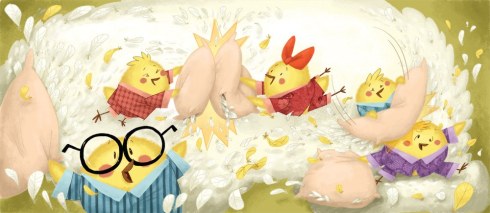
At first Mama scolds her chicks, but when she realizes her little ones are not ready for dreamland, she does something unexpected. Chicks Run Wild lets both parents and kids know it’s okay to break the rules every once in a while.

With a bright and cheery color palate, Ward Jenkins creates an adorable brood of five chicks with distinct personalities. One chick always has one eye opened, awaiting Mama’s departure. And there’s other fun details, like a spoof of the Beatles’ album cover Abbey Road, and Mama’s favorite read, Gone with the Wing. Sudipta’s jaunty rhyme makes you want to get up and shake your tail feathers with the family.
Bedtime is going to be a lot more fun with Chicks Run Wild. When your kids ask to read one more book, you’ll happily pick this one.
 Want it? Sure you do!
Want it? Sure you do!
Chicks Run Wild
Story by Sudipta Bardhan-Quallen
Illustrations by Ward Jenkins
Simon & Schuster Books for Young Readers
January, 2010





 9 Comments on Picture Book Review: CHICKS RUN WILD!, last added: 1/16/2011
9 Comments on Picture Book Review: CHICKS RUN WILD!, last added: 1/16/2011
 by Sudipta Bardhan-Quallen
by Sudipta Bardhan-Quallen
If you’re like me, writing is work. By this I mean it is my job, my primary source of income (therefore, work) but also that it is just plain HARD. There is nothing so depressing as trying to come up with something new and fresh to write about—and coming up with nothing.
That happens to me a lot.
So what do you do?
Well, I really don’t know the answer. But here are some tricks I use to muddle through those times when I have nothing to write about.
1) Start with character. I truly believe that the most important aspect of a picture book, what drives its popularity the most, is a charismatic main character. The premise, the setting, the cutesy word play and rhyme—all of these are secondary to character. So if you need to brainstorm only one thing, work on that viable character list.
The trick to creating a truly charismatic main character is to blend flaws with flair. Don’t just come up with fifty cute character traits. Give your main character some faults, some defects—he will be infinitely more interesting.
2) Something old into something new. There are so many examples of authors who take an old idea and make it into something modern and fresh. The entire genre of fractured fairy tales is built on the premise that recognizable is always a benefit for marketing, but recognizable AND fresh is money in the bank. Now I’m not at all recommending that all you do is read a collection of Grimm’s fairy tales and add a hippopotamus to each story (don’t do that, because it was my idea first). But if you can take inspiration from something your audience will recognize and then take it to a brand new place, where is the downside?
 Some examples of this in my own work:
Some examples of this in my own work:
THE HOG PRINCE – we know it’s a frog prince, not a hog prince, but Eldon does not.
QUACKENSTEIN – isn’t every monster story better with a duck?
THE TWELVE WORST DAYS OF CHRISTMAS – believe it or not, in addition to a Christmas song, this is a sibling story
3) Look at your own life. And I mean this as way to eliminate bad ideas. When you’re having a hard time with inspiration, there is the temptation to use your own children or grandchildren as your muses. Trust me, this is a bad idea. Because as cute as their latest antics are to you, they very rarely make for good picture books. Save yourself. Don’t do it.
4) Exercise. Well, do a writing exercise at least. When you’re really stuck you could reinforce your writing ability by taking a book that is perhaps not one of your favorites and then rewriting it the way it should be. Obviously, you can’t then try to publish your version of Dora the Explorer (because Nora the Explorer or even Eleanora the Explorer is simply not going to be fresh enough to merit a whole new franchise!). But the exercise will show you that you are not only able to create a new story but one that is better than something that was actually published (which means there is hope for you yet) and, again, you never know where that road will lead.
5) When all else fails, take a breath. Sorry, guys, sometimes the ideas are not going to come. No matter how much you force it. When you are really and truly stuck, stop trying so hard.
 Ever have one of those light-bulb moments when your manuscript finally gels? Your plot falls into place and you wonder why you didn’t think of something so simple and perfect before.
Ever have one of those light-bulb moments when your manuscript finally gels? Your plot falls into place and you wonder why you didn’t think of something so simple and perfect before.
Sitting in on Sudipta Bardhan Quallen’s picture book workshop last month, I had a dozen lightbulb moments. She dissected picture book structure like a biology teacher dissecting a frog–she split it wide open and showed us its heart. (OK, maybe that analogy wasn’t good for the squeamish, but she has a science background, so I think it works.)
For example, she suggested inserting a “ticking clock” into our manuscript. A deadline makes the story urgent and exciting. (Eureka!) If you’ve never heard her speak, you’re missing out on one of the finest picture book tutorials anywhere.
Besides being wicked sharp, Sudipta has a nervous energy that’s endearing. Get her engaged in conversation, and she’ll talk non-stop about her love of children’s literature. (And high heels and shopping on Bluefly. Yes, she’s a girly-girl like me.)
Surprisingly, she never dreamed of becoming a kidlit writer. She’d thought of being a doctor (but she’s afraid of blood), a model (but she likes to eat), and the President (but she had a dissolute youth). So much for childhood dreams.
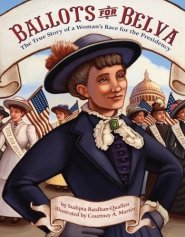 She’s the author of 11 picture books and 16 non-fiction books for children including The Hog Prince (Dutton), Ballots for Belva (Abrams) and Tightrope Poppy the High-Wire Pig (Sterling).
She’s the author of 11 picture books and 16 non-fiction books for children including The Hog Prince (Dutton), Ballots for Belva (Abrams) and Tightrope Poppy the High-Wire Pig (Sterling).
So Sudipta, if you didn’t want to be a writer, how did you get into the kidlit business?
I got pregnant twice in the span of 15 months and had to move from California (where I’d been going to grad school) to New Jersey (where a little piece of me dies every day). Like every other new mom in the world, I decided I had stories that I just had to tell my kids and so I started writing. I also had this idea that writing was totally a job I could do with two babies in the house, which was just stupid because you can’t do anything with two babies in the house.
Amen to that! I can’t do anything with two babies out of the house, either. (And by the way, I’ll let that NJ crack slide.)
When I started writing, everything was really bad. Some day, when I am super-famous, I will pull out my Alphabet book, and my going-to-the-zoo book, and all the other requisite bad stories we all write when we start. But eventually, I figured out to go to conferences and read up on the craft of writing, and I started to get things published.
How did you get your first big break?
About two months after I started writing, I wrote up a short story for Highlights. It was something that had actually happened to a friend of mine, with a bit of fictional dramatization. Highlights bought it and it was the first $200 I made writing.
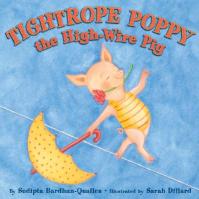 I also randomly got a foot in the door of children’s publishing by mentioning my science background in a cover letter. I’d sent a picture book manuscript to Sterling, which they rejected, but in the rejection the editor asked if I’d consider writing a science experiment book for them. That became Championship Science Fair Projects, which still sells really well for me, and a few years later, my first picture book, Tightrope Poppy, was published by the same editor.
I also randomly got a foot in the door of children’s publishing by mentioning my science background in a cover letter. I’d sent a picture book manuscript to Sterling, which they rejected, but in the rejection the editor asked if I’d consider writing a science experiment book for them. That became Championship Science Fair Projects, which still sells really well for me, and a few years later, my first picture book, Tightrope Poppy, was published by the same editor.
New writers are often told not to mention irrelevant information in queries, but your science background landed you a contract. What exactly is your science background?
I graduated Caltech in 1998 with a BS in Biology (by the way, with the passage of years and my gradual failure to remember even the most basic biology concepts, BS is becoming more and more appropriate). I spent a year at Harvard, but it really wasn’t for me, and then headed back to Caltech as a PhD candidate in developmental neurobiology. But those plans went off the rails when I had two babies. I had this crazy idea that I could write with two kids in the house—which you totally cannot do—but that’s how I got into the writing-for-kids business.
Normally, I recommend that you don’t mention anything other than kidlit in your cover/query letters, but if you keep it short and sweet, you can throw some things in there. I think the line I wrote was something like: “I have a Master’s degree in Biology from the California Institute of Technology and have published several scientific articles.” That doesn’t take up so much space that it is annoying.
What has surprised you most about being a published author?
So many things have surprised me about being a published author. Hard to pick just one. So I wrote a Top Ten list. I love Top Ten Lists. Except after I start writing and realize that I only have six interesting things to say. But who’s ever heard of a Top Six list?
Top Ten surprising things about being a published author:
- That the advances are so small that after everyone has had their cut and you’ve paid all your expenses (whether it’s permissions, or research costs, or just the cost of babysitting that allowed you to write the book) you have just enough money left over to take your family out to dinner. But only if they agree to go Dutch.
- That you can’t just show up at a book store and expect them to have your book. Or believe that you are a real author.
- That there’s a 50-50 chance that the number of kids that are biologically related to you who show up for a book signing will outnumber the number of kids that are NOT biologically related to you.
- That no matter how much market research you’ve done, there’s a good possibility that there is a really similar book out there that no one has ever heard of – except the person writing the review.
- That even though the publisher picks up the tab for producing the book, all of the marketing responsibility is on you. So if you want anyone beyond your mother and your best friend to know about it, you need to get your butt in gear.
- That you know no more about writing or publishing after the contract than you did before. Even though everyone expects that you do.
- That the more successful you get and the more books you publish, the less of your writing time will actually be devoted to writing.
- That when you and a group of writing colleagues meet certain editors (who may now be agents…), no matter how many books you’ve done, the first comment he will make is, “So… you all are *moms*, huh?”
- That it is a long time before you move “real author” into the list of things you consider yourself. I still haven’t really gotten there.
- That going to a school for an author visit is as close to being Angelina Jolie as you will ever get. And it’s a pretty cool feeling.
How did you begin to bill yourself as a speaker?
I started to volunteer to speak at conferences because I wanted to teach what I had learned about the craft of writing picture books to other aspiring writers. I got a lot out of SCBWI events in New Jersey, and I wanted to give back. Also, teaching helps you learn in ways that doing does not. For example, at this year’s NJ-SCBWI annual conference, I gave a workshop about rhythm, rhyme, and repetition. I talked about using a refrain in your picture book manuscript to give it narrative structure—and it was the first time I had consciously realized that that was something I do a lot in my own writing. Having to teach it, however, was what made me conscious of it.
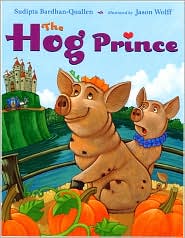 Some authors say they learn something about themselves with each new book. What did writing The Hog Prince teach you?
Some authors say they learn something about themselves with each new book. What did writing The Hog Prince teach you?
In my workshops, I emphasize the importance of the market over and over again. I’m constantly saying that I only write what I know I can sell. But as I review my own body of work, which has finally grown large enough that I feel comfortable calling it a body of work, I notice that, within the confines of what I feel the market can bear, there are themes that I subconsciously explore time and again. And these are the themes that resonate most strongly for me.
In The Hog Prince, Eldon dreams of being something he is not. He believes that if he were to change by magic, his life would be better, that everything would be shiny and pretty and luxurious and grand. And while I run the risk of coming off as having no self-esteem at all (which is not true, I have an itty-bitty bit), I can say that there have been plenty of times in my life that I have felt this way. In fact, I don’t think it is just a childhood thing–I’m not sure that we ever completely grow out of feeling like everything about our lives would be improved if only we could change ONE little thing. Except that it is never a little thing, nor is it one thing, nor will your life actually get better.
What’s nice about the story is that Eldon figures out that he is worthy and precious just the way he is, and that the folks who really matter (in his case, Petunia) don’t want him to change one muddy little thing. I struggle with this lesson, and I think a lot of kids do, too. Hopefully, that’s what makes the story timeless.
So, here is what I learned about myself:
- I sometimes wish I could change into royalty;
- I use my books to sort out emotional issues;
- I think that every story is better is you replace the main character with a pig.
You may be right there. I mean, who doesn’t love pigs? I mean pigs in literature. Real pigs, not so much.
Thanks for the interview, Sudipta! I think I know what the blog market can bear, and although I’d love to talk to you for another thousand words, something’s telling me to wrap it up here.
More of Sudipta’s serious-yet-sassy picture book philosophies can be found on her new blog, including a picture book writer’s Ten Commandments. Thou shalt not submit a manuscript before its time…
















 y
y 

 It’s back to school season here in New Jersey (or, outside Philadelphia, as I typically refer to it) and that means big changes in my household. All summer, my kids and I are bums. We hang out at the beach, at the pool, at the mall. We travel, we sleep in, we do nothing. Summer is heaven.
It’s back to school season here in New Jersey (or, outside Philadelphia, as I typically refer to it) and that means big changes in my household. All summer, my kids and I are bums. We hang out at the beach, at the pool, at the mall. We travel, we sleep in, we do nothing. Summer is heaven.
 Sudipta is an award-winning author of over 40 books and the co-founder of both
Sudipta is an award-winning author of over 40 books and the co-founder of both 

 by
by 



 Too much of anything is good for nothing.
Too much of anything is good for nothing. Use this principle in your marketing materials, too. Having bookmarks printed? Think about designing something that works for all your new releases. Making postcards? Create a “New for 2014” card instead of individual designs.
Use this principle in your marketing materials, too. Having bookmarks printed? Think about designing something that works for all your new releases. Making postcards? Create a “New for 2014” card instead of individual designs. by
by 



 by Sudipta Bardhan-Quallen
by Sudipta Bardhan-Quallen



 So, you’ve finished PiBoIdMo, and now you have all these great ideas. You’re on the road to publication!
So, you’ve finished PiBoIdMo, and now you have all these great ideas. You’re on the road to publication!
 I have no new ideas.
I have no new ideas. I took my nugget and grew it to a title. And from there, I…well, ran wild with it. Now, let’s be honest, I took this title and then did what writers all over the world do every day: I wrote about what I knew. CHICKS RUN WILD grew into the story of little chicks at bedtime who don’t want to go to sleep quite yet—it could be an autobiography of bedtime with my own children. So, easily, I could advise you to take inspiration from your life—but you get that everywhere, don’t you? Besides, my point is I only got to writing about what I knew after starting with a small nugget of inspiration. I nurtured that nugget and kept it warm and safe until it grew into a fully formed…idea.
I took my nugget and grew it to a title. And from there, I…well, ran wild with it. Now, let’s be honest, I took this title and then did what writers all over the world do every day: I wrote about what I knew. CHICKS RUN WILD grew into the story of little chicks at bedtime who don’t want to go to sleep quite yet—it could be an autobiography of bedtime with my own children. So, easily, I could advise you to take inspiration from your life—but you get that everywhere, don’t you? Besides, my point is I only got to writing about what I knew after starting with a small nugget of inspiration. I nurtured that nugget and kept it warm and safe until it grew into a fully formed…idea.



 by
by 
 Ever have one of those light-bulb moments when your manuscript finally gels? Your plot falls into place and you wonder why you didn’t think of something so simple and perfect before.
Ever have one of those light-bulb moments when your manuscript finally gels? Your plot falls into place and you wonder why you didn’t think of something so simple and perfect before. She’s the author of 11 picture books and 16 non-fiction books for children including
She’s the author of 11 picture books and 16 non-fiction books for children including  I also randomly got a foot in the door of children’s publishing by mentioning my science background in a cover letter. I’d sent a picture book manuscript to Sterling, which they rejected, but in the rejection the editor asked if I’d consider writing a science experiment book for them. That became Championship Science Fair Projects, which still sells really well for me, and a few years later, my first picture book, Tightrope Poppy, was published by the same editor.
I also randomly got a foot in the door of children’s publishing by mentioning my science background in a cover letter. I’d sent a picture book manuscript to Sterling, which they rejected, but in the rejection the editor asked if I’d consider writing a science experiment book for them. That became Championship Science Fair Projects, which still sells really well for me, and a few years later, my first picture book, Tightrope Poppy, was published by the same editor.


I love the graphic organizer. Thanks for sharing. These are great tips and suggestions.
Sudipta, your post was very helpful and I can’t wait to read “Rutabaga Boo.” I love all your books! Thanks for being an inspiration
I love the salt analogy! Thank you Sudipta for an inspiring post!
Wonderful insight about how to make compelling characters. Great graphic organizer for this process.
Great info regarding characters. Can’t wait to use the graphic organizer!
Such helpful information. As a children’s storyteller, my characters and their “tiers” come to me naturally when I’m performing, but as I try to turn these tales into books, I sometimes struggle with getting the characers to come to life on paper. Thanks for the insight.
Wedding cake not cupcake–that is such a great tip for working in layers! Thanks for a great post!
Woke up to your wonderful post! Thanks so much! Going over my ideas & building characters. Now I’m hungry for (salty) cake! :)
Great analogies! Always enjoy reading your character development lessons. You make some great points and I love that you tie it all in to food…after all, who doesn’t love cake! Thanks again for the insight!
I love character driven books. thanks on the advice on how to write one.